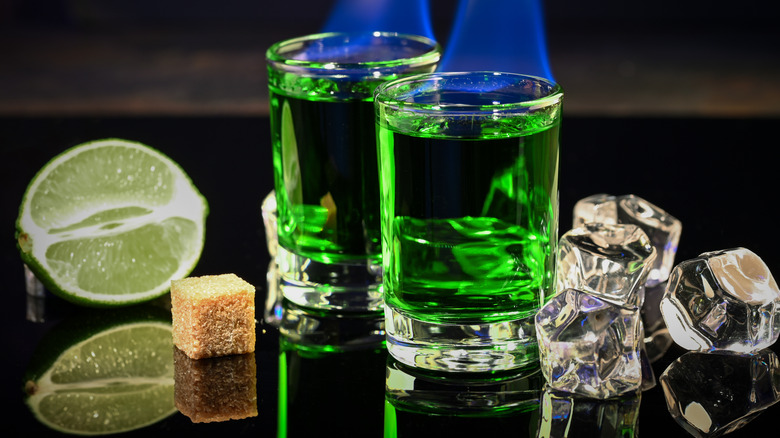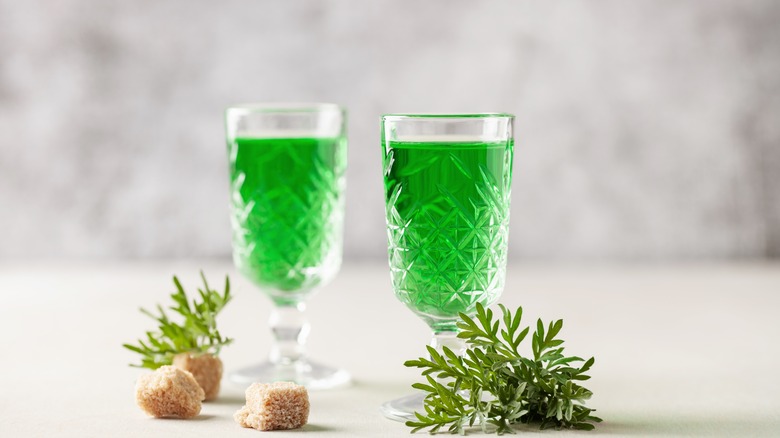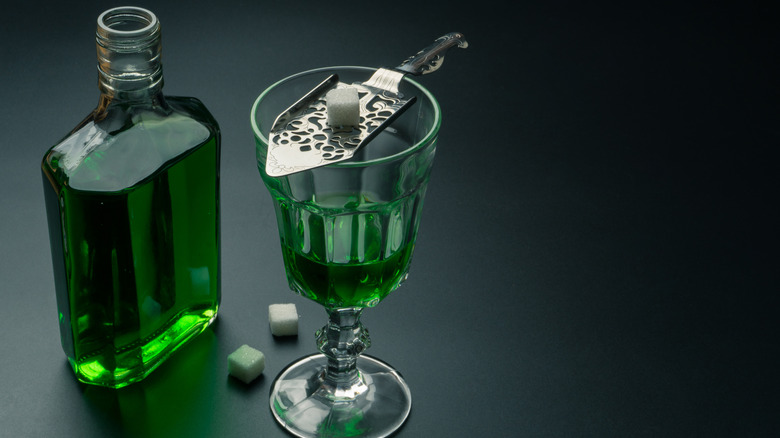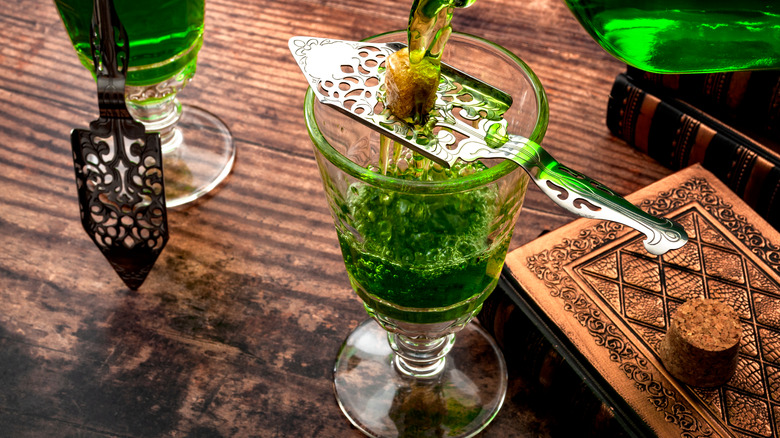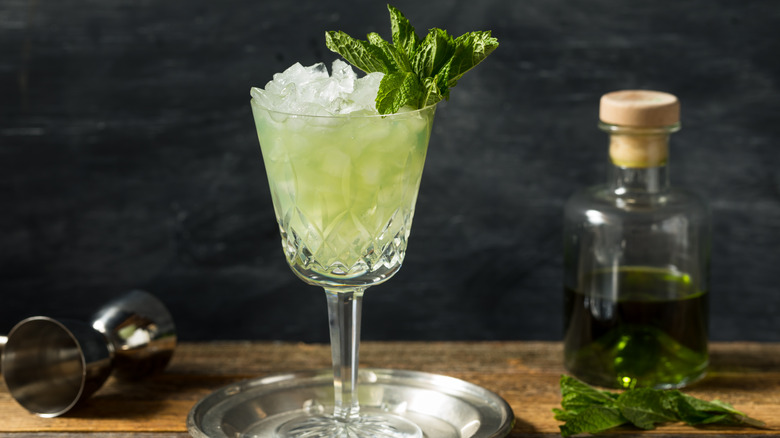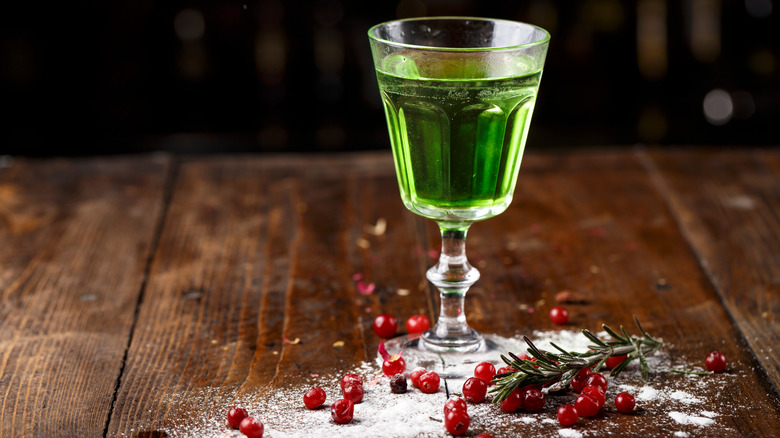The Ultimate Guide To Drinking Absinthe
Absinthe is arguably the most fascinating yet misunderstood alcoholic beverage globally, shrouded in myths and tales of hallucinogenic properties. Today, it is largely seen as a surefire way to end up with a blurry night, particularly among young revelers. Moreover, absinthe's history is marked by periods of legality and illegality.
Known as la fée verte or the green fairy, absinthe is believed to have derived its name from "apsinthion," the Greek word for either wormwood — the primary ingredient in the spirit — or "undrinkable." While wormwood had been utilized for its medicinal qualities by ancient Egyptians and Greeks, it was its bitter taste that led to the creation of absinthe. According to legend, a French-born physician named Dr. Pierre Ordinaire concocted the green spirit in Switzerland. He aimed to make the medicinal properties of bitter wormwood easier on the tongue by distilling grape spirit with 15 macerated botanicals, resulting in the birth of the first absinthe in 1792.
Initially labeled as "Extrait d'Absinthe" after its namesake (Artemisia absinthium) for wormwood, absinthe was intended to serve as a healing tonic, believed to prevent a range of ailments from fevers to dysentery. However, as the phylloxera plagues devastated much of the wine and brandy production in 19th-century Europe, absinthe gained popularity as more than just a medicinal potion. During the Belle Époque period, figures like Pablo Picasso and Vincent Van Gogh indulged in the green fairy for leisure, finding inspiration for their art in its consumption.
What is absinthe and why was it banned?
Absinthe is a botanical spirit with a high ABV (alcohol by volume). While beverages like rum and whiskey typically have ABVs of up to 50%, absinthe stands out as an overproof spirit with an ABV exceeding 50% and ranging between 90 to 170 proof. Despite its notorious potency, the enigma surrounding absinthe and its precarious legal status can be attributed to its key ingredient: the mysterious wormwood.
As the popularity of absinthe spread across Europe between 1850 and the early 1900s, so did the incidents of crime associated with its consumption. The turning point against absinthe came with the infamous 1905 case of Jean Lanfray, who murdered his wife and two daughters. This violent crime was attributed to a day of absinthe-drinking, even though Lanfray had reportedly been consuming a cocktail of spirits in the lead-up to that day.
In an effort to save French society from its supposed absinthe-related ruin, psychiatrist Dr. Valentin Magnan sought to establish that thujone — a chemical found in various plants, including sage and wormwood — was the root cause of the violence and debauchery associated with absinthe. He used observations from his own experiments conducted on animals to argue that absinthe possessed psychoactive properties that led people to madness. Pressure from lobbyists, along with the desire to curb absinthe's popularity, turned the green fairy into a symbol of Prohibition, resulting in a ban on absinthe in Europe and the U.S. for over 100 years.
What is absinthe made of, and what does it taste like?
Dr. Ordinaire's 18th-century recipe, which distilled herbs and grape spirit to create the green fairy, is still the formula used for making most absinthe today. The process of crafting absinthe begins with a clear distilled spirit called eau de vie, made from white grapes, into which a variety of herbs and spices are macerated in two stages of redistillation. These botanicals include wormwood, fennel, and anise — the three ingredients that constitute the holy trinity of absinthe. Additionally, other ingredients like star anise, lemon balm, peppermint, coriander, and hyssop are used.
While wormwood imparts absinthe with its signature green hue and its notorious reputation as a hallucinogen, it is also responsible for giving the drink its distinctive flavor. Often described as reminiscent of black licorice candy, which it derives from anise and fennel, absinthe also possesses a noticeable bitterness from wormwood, along with sharp and floral notes from fennel. However, it's worth noting that different methods of absinthe production in various parts of the world can influence its precise flavor and color. Some absinthes are more bright than bitter, while others are more minty and floral. French methods, for example, rely on longer maceration, resulting in a darker shade of green, whereas Swiss varieties, with single distillation and shorter maceration, have a whiter hue.
How to drink absinthe
Due to its high alcohol content, absinthe is almost always diluted and rarely consumed on its own. A classic preparation, known as the absinthe drip, involves placing a cube of sugar on a slotted spoon carefully balanced over a glass of absinthe. Cold water is then poured over the sugar cube, which slowly dissolves into the absinthe below, turning it into a thick and cloudy liquid in an effect known as louching. There is also a less laborious way to somewhat replicate the absinthe drip: simply stir half an ounce of simple syrup into five ounces of cold water for every ounce and a half of absinthe.
Absinthe serves as the base for cocktails such as the chrysanthemum, which includes vermouth; the monkey gland, a mix of gin, orange juice, and grenadine; the morning glory fizz, which works as a "hair of the dog" cocktail; the absinthe-spiked version of a whiskey sour known as the rattlesnake; and the famous New Orleans-based Sazerac cocktail, made with cognac and bitters. Absinthe's herb-like flavors pair excellently with citrus and other fresh botanicals, especially in cocktails that combine a variety of flavors. Additionally, absinthe's herbaceous flavor enhances cocktails when used in dashes, similar to bitters, or when used to rinse glasses before pouring a drink into them.
Myths about absinthe that you shouldn't believe
A primary concern about absinthe when it was banned was thujone. However, a 2008 study published in the Journal of Agricultural and Food Chemistry suggested that nothing besides ethanol could explain the symptoms of absinthism — such as facial contractions, seizures, mania, and psychosis — related to drinking absinthe (via Healthline).
Even then, ethanol is a chemical present in all alcoholic drinks, so its aftereffects are hardly unique to absinthe. Furthermore, the 2008 study found that the hallucinogenic and psychoactive properties attributed to absinthe were inaccurate, with the more reasonable explanation for the green fairy's notorious reputation being linked to its high alcohol content instead. Moreover, modern absinthes are regulated by the FDA to contain no more than 10 parts per million of thujone, or 10 m.g. per liter, to be labeled as thujone-free in the U.S. Therefore, if you do experience negative symptoms after drinking absinthe, it's likely the result of consuming too much alcohol rather than absinthe alone.
Where to buy absinthe
If you're interested in trying out absinthe for yourself, don't worry. The green fairy was legalized again in the entire European Union in 1988, with the condition that the thujone content would not exceed 10mg/kg or 35mg/kg for bitters. In the U.S., it was similarly legalized in 2007 under comparable regulations, nearly a century after its original ban in 1912.
Since its renewed legal status, absinthe is readily available in most parts of the world and can be found in liquor stores, much like other spirits. Pernod, whose founder Henri-Louis Pernod played a role in establishing the world's first commercial absinthe distillery in 1798, remains a widely available brand of absinthe in the United States. Absinthe is also more popular in bars than it was before, with absinthe-based cocktails commonly featured on menus. Additionally, New Orleans has a legendary reputation for absinthe-based drinks — it did give the world its first Sazerac, after all.

